The Jewel in Sri Lanka’s Crown - The Lion Rock of Sigiriya
The UNESCO World Heritage site of Sigiriya is probably Sri Lanka’s most important attraction. A massive ancient stone fortress set atop a mountainous rock in the heartlands of Central Sri Lanka, the Lions Rock (also known as the Lion Rock or Sigiriya)is an unmissable part of any visit to this beautiful island. We have explored the ruins of Sigiriya twice now (it is just that good) and have come up with this complete guide for visiting!
Each country has its own iconic landmark, from the Eiffel Tower to Big Ben, the Taj Mahal to Machu Picchu. Places so famous that you feel almost obliged to visit. There’s the irrational fear that by missing a country's primary attraction you may be stopped at the border and turned back! Sri Lanka’s “unmissable” landmark is the Lion’s Rock of Sigiriya.
Sigiriya was one of the main reasons we came to Sri Lanka in the first place. Back when we were at work in an office, an old screen saver on a colleague's computer had kindled our interest. A dramatic ruined fortress town sitting impossibly high up on top of a lonely rock formation, surrounded by lush green forests - it had looked like something from a story, some kind of lost world.
A brief Google search and we had a name. Sigiriya, the Lion Rock of Sri Lanka.
As we’ve mentioned before, we love a good ruin (have a look at Ritigala here), and Sigiriya had all the intrigue, majesty and drama we could ever want. A screensaver was not enough We had to see it in real life!
Not to spoil the surprise but we found Sigiriya to be one of the most incredible experiences in all our time in Sri Lanka. We loved it so much we actually looped our route around the island so we could visit it twice! Below is our experiences and guide to this incredible UNESCO World Heritage site.
The Complete Sigiriya guide:
Essential Information:
Disclosure: This article may contain affiliate links. We will earn a small commission from any purchases made through these links.
A Brief History of Sigiriya
Sigiriya absolutely dominates the surrounding landscape. Visible for miles around, the rock towers out over the forests and paddy fields below.
Sigiriya was built by King Kashyapa in the fifth century after he had usurped the throne, exiled his brother and caused the death of his father (he was a busy boy!). King Kashyapa understandably now felt the need for a new, more defensible capital. With the same display of arrogance, common throughout kings of the world, he selected the top of a near vertical rock formation for his new fortress.
Relocating the local monks to another nearby outcrop (Pidurangala), he went about constructing his palace on top of the giant rock as well as building water gardens, meeting halls, temples and even an enormous moat. King Kashyapa’s reign came to a bloody end not too long after it started with his brother returning from exile and bringing with him an army. The king's own forces deserted him and he killed himself rather than be captured by the brother he tried to murder.
The now abandoned Sigiriya was quickly swallowed up by the surrounding jungle, the legend of its existence surviving only in Buddhist texts and the knowledge of locals.
Fast forward a few centuries to the 1800s, and the colonial British were in town (yes we got everywhere, we truly were the COVID of colonists). George Turnour, or more likely his Sri Lankan helpers, translated the texts that identified Sigiriya. Later a Scotsman named Jonathan Forbes led an expedition to the area in 1831 and successfully located the ancient city. Twenty years later, the summit of the rock was finally reached by a group of British mountaineers. Harry Bell, the then Archaeological Commissioner of Ceylon, completed a detailed survey of the site and successfully uncovered the Lion’s Paws that give the rock its name. Sigiriya was designated a UNESCO world heritage site in 1982 and has been drawing visitors ever since.
Visiting the Ancient Fortress of Sigiriya
Sigiriya is one of the more expensive attractions in Sri Lanka, but, that did not stop us visiting twice, its just that impressive! Our first visit was during our stay at Roy’s hostel (book your stay here) where we had an incredible afternoon and evening watching the sun set from the top of Sigiriya. Our second visit was around a month later (whilst staying more locally at the excellent Sigiri Saman Homestay), where we visited in the morning to allow us more time to explore the site.
If you arrive by car or tuk tuk (like we did from Roy’s) you will be dropped off at the main car park next to the ticket office. If you’re staying more locally and come by foot, then there are a couple of entrances that you can use. We walked in from the entrance closest to the village of Sigiriya. This route had the added bonus of a very impressive walk along the edge of the large moat that surrounds the ancient city.
You can find the car park here and the walking entrance from Sigiriya town here.
Tickets to the site cost $36 USD (updated March 2024 - Thank you Mark and Heather!) which is also payable in local currency, or on card (Visa definitely). Tickets are purchased via a ticket counter inside the museum building. Most visitors, including us on our first visit, pick up their tickets, turn around and head straight to the ruins, bypassing the museum altogether. Do not skip the museum! We only found out how much we had missed on our second visit.
Sigiriya Museum
Okay, confession time; we only went into the museum on our second visit as it was air conditioned and John was melting. But, after cooling off, we found ourselves drawn into the exhibits and decided to check it out properly.
Set over two floors, the museum starts off less than stellar. There is a large collection of very small photographs housed in a cavernous room, whose ceiling has so many fans it's a wonder it doesn’t fly off like a helicopter! After the helicopter room, the museum picks up speed and grows in interest with rooms full of archeological artefacts, dioramas and information on Sigiriya and the surrounding area's history. They have reconstructions of the rock face so you can get a closer look and even a traditional house you can walk through. There are lots of interactive exhibits and displays you can touch and feel. The museum has done a good job of appealing to visitors of any ages. A young John would have especially loved the replica weaponry you can play with!
The museum building itself is an impressive structure. Me and John are no experts in architecture, but do really love a bit of Brutalism. If you’re not from the UK, please Google the London Barbican Centre as the museum really reminded us of its style. The museum building was a fantastic mixture of brutal concrete, sharp edges and uniform shapes all softened by flowing water and contrasting soft green foliage.
Concrete never looked so pretty!
Parts of the museum had been left open to the sky, with trees climbing through the floors, winding up and out of the artfully designed roof.
History lessons learnt, architecture admired and sweat subsided we headed out to the ruins.
The Ruins of Sigiriya Rock Fortress
After dodging through the gauntlet of guides (see our tips section later) and handing over our tickets to the gate attendants, we crossed a bridge over the moat and entered the ruins of Sigiriya.
When you enter a long path stretches out in a straight line in front of you all the way to the base of the rock. Spread out to the left and right of the path, lie the ground level ruins of the ancient city. Take the path to the right as soon as you enter the grounds and it will lead you up a bank where you can get a fantastic view of Sigiriya and the ruined gardens.
Back on the main route, the path winds through the ruins and you will find yourself going past ancient fountains that are fed from ponds all the way at the top of the rock. The fountains were not flowing when we visited, but have heard that it does still operate in times of heavy rain. These fountains form part of the extensive and beautiful ancient water gardens. We are not experts on gardens, archaeology or anything really, but we can vouch that they are stunning!
One of the fountains in Sigiriya’s water gardens.
For those who want a more in depth historical analysis we’d recommend this article.
Climbing the Lion Rock, Sigiriya
Winding through the ancient gardens you can veer off left to find caves, as well as an octagonal man-made lake sitting under the shadow of the rocky monolith. However if you continue straight on, it's time to climb the rock itself.
Heading through a natural arch formed by two large boulders, the path snakes upwards, circling around the rock to the left hand side. According to the signs, this portion of the path is a natural rock garden, contrasting to the ordered geometry of the water gardens below.
On both of the days we visited it was swelteringly hot. John had sensibly decided to wear a pink shirt (both times, he doesn’t learn lessons), which almost immediately changed colour to a dark red under the sheer volume of sweat. This was all before we had even reached the first plateau.
Sharing the climb with troops of monkeys and the occasional street dog, we ascended the first set of stone stairs. At the top of this first staircase, the path opens up and levels out into the first plateau and our first chance to stop and enjoy the view. On this level there are some large rectangular ruins (we never learnt of what, but we like to imagine it was an ancient refreshment stall).
Catching our breath and downing some water we continued on up. This was when Ellie spotted the very large spider, its legs stretching out between the stone steps. We elected to hop over this step and its spindly guardian!
On the next plateau we were greeted by one of the most iconic sights of Sigiriya and maybe even Sri Lanka as a whole. Two gigantic Lion’s paws with claws extended, sit either side of a grand stone staircase. These majestic paws are all that remain of the carved stone Lion that sat guarding the final staircase to the ancient palace above. These are the paws that gave Sigiriya the name of the ‘Lion Rock’. The lion’s body and head are long since gone, collapsed and swallowed by the jungle. These giant paws now mark the transition between the ancient stone staircase and the modern metal route up the mountain.
A word of caution here, there are signs everywhere advising to be quiet as this is an area prone to wasp attacks. We thought this might be slightly over cautious until we saw the size of the hives hanging off the rock above! The area will be closed if there is a wasp attack so be careful! Check out the tips section at the end of the blog for more information.
On Top of the Ancient Fortress - the View from the Lion Rock
The final upward stretch (especially in the 30+ degree heat and blazing sun), is not pleasant despite the incredible view. By the time we had reached the top - 1200 steps in total - we were sweaty, tired and dehydrated! The view from the top however made up for it all.
Can you guess who was carrying the rucksack?!
Sigiriya is the tallest peak around and gives a complete 360 degree view over the Sri Lankan jungle below. Spread along the horizon, jagged blue mountain peaks can be seen, whilst below lakes and rivers sparkle and wind through the verdant green of Central Sri Lanka.
We’ve climbed many mountains with amazing views before. But often these views are framed by a cityscape in the distance, a main road snaking through or an inconveniently placed pylon. Sigiriya was different. The landscape appeared to be almost primordial, like something from the set of Jurassic Park. We’re not saying there were no roads or infrastructure visible, but if there was, it was dwarfed into insignificance by the overwhelming surrounding nature.
Looking to the north we could see Pidurangala Rock, rising like a little volcano out from the forest below. At this distance and looking down on Pidurangala, it looked small in comparison to the behemoth we had just climbed. We know it is not small in reality (it certainly didn’t feel small when we climbed it), but the perspective given by Sigiriya made everything surrounding look tiny!
The first time we visited Sigiriya, we arrived in the late afternoon in order to watch the sunset from the top of Sigiriya. This was fantastic, the panoramic view as the sky changed colour was truly incredible. We sat for the best part of an hour, in silence, watching the evening swallows wheel and cascade overhead whilst the sun dipped down below the horizon. We would have stayed longer, but didn’t fancy the climb down in the pitch black!
The second time we visited, we arrived much earlier in the day, reaching the peak by early afternoon. Although it didn’t have the drama of a sunset, this was arguably a better time as we could explore the ruins more thoroughly, and enjoy the views in all their glory.
There are many, many structures, platforms, pools and ponds at the top of the rock and we spent a good amount of time wandering about, taking selfies and generally being awestruck by the staggering sites surrounding us.
The ruins of the ancient city are amazing, set over varying levels with steep staircases, connecting different “floors” with each other. On one end of the palatial rock sits a large carved pool. This pool, which feeds the fountains below, was only half full, but was still improbably large for something sitting at the top of an enormous boulder!
A lone tree grows out of a ledge overlooking this pool, and provides not only a great viewpoint of the ruins, but a very romantic selfie spot, if we do say so ourselves!
Walking around the remains of Sigiriya, every turn would reveal a new vista or ruin and a near infinite number of photo opportunities.
Despite the steep hot climb up the Lions Rock, it hadn't quite managed to register to us with us just how high up we were. Looking back down to the water gardens, it was as if we were looking at a map from above.
We kept looking at distant points wandering what they were, only to realise it was something we had walked through earlier that day.
It was about this point we saw the most incredible escape!
He was as shocked as us!
A large lizard was stalking a much smaller gecko, with a view of making it into lunch. The large lizard pounced and the smaller lizard literally leapt off the cliff. Thinking we had just witnessed a lizardy suicide we rushed to the edge only to see the gecko impact with a ledge a good 100 metres below. It skidded, stopped and finally (this maybe our imagination) looked back up with a smug saurian smile. The larger lizard stared over the edge for a moment before slinking off to find some other, less daring lunch.
Other notable wildlife sightings we saw at the top of the rock include monkeys, eagles and a small collection of street dogs who seemed to have their Instagram poses on point!
He knew how to pose!
Both times we visited we were blown away by the views, ruins and atmosphere at the top of Sigiriya. Memory cards full to bursting and enough selfies to collage a bathroom (on both times, John isn’t the only one not to learn lessons), we headed back down.
The Mirror Wall
As you descend there is a fork in the path between the Lion’s paws and the first plateau. One route takes you down to the gardens the same way you came up and the other turns left, clinging precariously to the face of the rock. During our first visit, as we were descending after sunset, we were too late to take this other path, but on our second visit we had enough time to take the left route and visit the ‘Mirror Wall’.
The ‘Mirror Wall’ is not a mirror (per se). Previously encased in plaster, the wall was polished to a shine which gave it its name. On the rock face side of the wall is the pathway which lets you in on the secret to the ‘Mirror Wall’.
The side facing the rock is crowded with centuries and centuries of graffiti. Visitors from way back in time leaving their thoughts of Sigiriya carved into the wall. Further along from the ancient graffiti, the path leads up a set of spiral stairs to the famous murals.
Painted onto the walls of a large cavernous overhang, colourful frescoes are all that remain of a vast tapestry of cave paintings that are thought to have extended all the way around Sigiriya. The paintings are of beautiful scantily clad figures and have been the subject of much debate. Some claim they are holy beings scattering offerings whilst others state that they are paintings of the concubines of the king's harem.
Exiting the Mirror Wall and cave paintings, we descended to the gardens below. On our first visit we had to hurriedly make our way to the exit as the park was closing and the light was fading so we missed exploring any further. Our second visit allowed us to correct our previous error and seek out the treasures we had missed.
Earlier we spoke about the pool and caves you can find to the left of the main path approaching the rock face. Coming down the rock you will be directed to the right of the path (confusingly this will now be your left with the rock behind you). There is a wealth of things to spot here from the ‘Cobra Head Cave’ (yes it does really look like a cobra getting ready to strike), an ancient urinal and even a reception hall carved into the top of an especially large boulder. The path eventually wiggles you out to the car park and the obligatory arcade of tourist shops.
Final Thoughts - Sigiriya is it Worth it?
Sigiriya is famous for a reason. We mentioned this already in our Pidurangala article but it really should not be skipped. If you’ve travelled all the way to the Indian Ocean and have made your way to the centre of this incredible island, you really would be missing out by not visiting. Yes the ticket price is expensive, but coming from London we could easily spend the same on a tame night out in a pub. We would say Sigiriya is a once in a lifetime experience but it was so good we had to do it twice.
“Pensive? Damn I was going for thoughtful”
It's tempting whilst backpacking to minimise costs and maybe skip something as touristy and expensive as Sigiriya, but we cannot stress how glad we were to do this twice. You can see as many photos as you want, but the views from the top and the atmosphere of the place were truly incredible.
We visited in very strange times in 2022, during civil unrest, financial crisis and worldwide governments advising against all travel to Sri Lanka. On both our visits, there were never more than ten to fifteen other people at the top of the rock. This was amazing for us, and our photos, but obviously tragic for the people of Sri Lanka and the archaeological site itself. Like we’ve said before about the beaches of Uppuveli and Nilavelli these places are wonderful and really deserve the visitors. We hope that next time we visit (yes there will be a third time!) that the Lion’s Rock is back to wowing crowds of awe struck visitors.
Tips and Essential Information for Visiting the Lion Rock of Sigiriya
Where is Sigiriya, how can I get there?
Getting to Sigiriya from Central Sri Lanka - local busses and tuk tuk’s
Sigiriya is located in Sri Lanka’s central region, near the towns of Habarana, Kimbissa and Dambulla. Dambulla is the best connected of these nearby towns, with public transport links to Colombo, Kandy as well as other major Sri Lankan towns and cities.
The town of Sigiriya can be reached by public bus from Dambulla, tickets for the public buses can be brought on the day once you have boarded the bus. To catch the Sigiriya bus from Dambulla just head to the bus station (here) and ask.
From any of the other local towns tuk-tuks or Taxis can easily be arranged to get you to Sigiriya. There may also be other local busses that will take you past Kimbissa Junction - see below. Alternatively, any accommodation will be happy to help sort out transport for you, there may just be a little premium pricing!
Getting to Sigiriya from further afield: Buses, taxis and trains
Sigiriya by bus
You can get a bus to Sigiriya from anywhere on the Island of Sri Lanka. There will be a bus terminal in every town and city and from there you should be able to get a bus to Dambulla. Alternatively, take the any bus that goes past Inamaluwa junction, otherwise known as Sigiriya or Kimbissa junction. The junction is on several major routes between Dambulla, Polonnaruwa and other larger towns. At the junction jump off the bus and grab a tuk-tuk to Sigiriya town.
We managed to get all over the place by hopping from one public bus service to another, but it can be quite time consuming. We had an epic 12 hour journey on 4 different busses between Arugam Bay and Sigiriya! Whilst it was exciting, we wouldn’t recommend it if you were short on time!
You can always book ahead on one of the many tourist buses throughout Sri Lanka for piece of mind. These tourist buses and minivans tend to be air conditioned and will run pretty much from anywhere to anywhere. Check out 12Go to see what you can arrange.
Sigirya by train
There are trains you can get to stations near Sigiriya. if you are coming from Trincomalee or Colombo you can ride the rails to Habarana Railway Station and change to a tuk-tuk. There is also Kekirawa Station nearby with links to Colombo (tickets can be bought here). The train services to these two stations are irregular so make sure you plan accordingly!
Taxi’s and private transfers to Sigiriya
For the most direct route to Sigiriya you can arrange private taxi’s from anywhere on Sri Lanka. Taxis can be surprisingly affordable and convenient, especially if you are travelling in a group:
Taxi from Colombo city to Sigiriya
Where To Stay Near Sigiriya?
If you’re making Sigiriya a destination, you may well find yourself staying around the base of the Lion’s Rock in the town of Sigiriya. You can read all about the town outside Sigiriya Rock in our article here. There are plenty of accommodation to chose from in the surrounding area, from boutique hotels, luxury resorts, small guesthouses and even some excellent hostels. We stayed once at the excellent Roy’s Hostel and once at the cosy and beautiful Sigiri Saman Homestay.
If you are looking for a luxurious stay in Sigiriya check out the opulent Sigiriya Kings Resort or if you are looking for the money-no-object ultra high end accommodation, have a look at Water Garden Sigiriya.
You can have a look at all the accommodation options around the Lion Rock below (you may need to zoom in or out):
What is the entrance fee to Sigiriya?
One ticket costs $36 USD which is payable in USD or Sri Lankan rupee at the day's exchange rate. Since we visited we they have started to accept card (Visa certainly) payments, there may be a small fee if you use this method (also check your bank doesn’t fleece you on the exchange rate!).
The $36 entrance fee includes access to the museum. If you just want to visit just the museum (maybe if you’re in town and didn’t want to overdose on history in a single day) then entrance to the museum costs $5.
These prices were updated in 2024 (thanks again to Matt and Heather).
What are the Lion Rock’s opening hours?
Sigiriya is open from 7:00am to 17:30pm. This closing time is for new people entering the park. When we visited for the sunset we exited the park well after 18:00pm we don’t know if this is usually allowed though!
To check up to date information about opening times, ticket prices etc follow this link.
Food and drink at Sigiriya
There is a cafe/stalls near the ticket counter and the car park exit which sell water, soft drinks, snacks and ice-creams.
There is a free water fountain / bottle refill point giving out filtered water. This is where we filled our bottles before climbing the rock. The free fill point is located just before the ticket gate into the main site.
There was also a restaurant on site but this was not open when we visited. If you go let us know in the comments how it is!
Just outside of the Lions Rock is the small town of Sigiriya, which has lots of small restaurants and shops. Check out our guide here:
Are there toilets at the Lion Rock?
Yes but only at the base before going through the ticket barrier. There was no toilet paper in the ladies loo when Ellie visited, but they were western toilets (Princess here doesn’t like getting her leg workout done on squatty toilets)!
Can I get a guided tour of Sigiriya?
Yes you definitely can! There are many, many people offering guided tours, usually wearing blue t-shirts with yellow collars. The guides will come to you and offer their services for a price. We politely declined about fifteen of these offers and ignored their increasingly high pressure sale pitches!
When we were there in 2022 the guides were offering their services for between $5 and $10. This may be a reduced fee as there were so few visitors.
If your looking to make the most of a shorter trip in Sri Lanka’s heartlands think about combining a few experiences, have a look below for some tours that offer a few of the regions “greatest hits":
Do I need a guide for Sigiriya?
This is down to personal preference. We always find that we prefer to explore a site ourselves and at our own pace, but if you like to know more about what you’re seeing then a guide is a great way to get the most out of an experience.
There were a few sign boards dotted around the ancient gardens giving a brief overview of the history, but often you were left to your own imagination to decide what you’re looking at.
As we’ve mentioned above, we would highly recommend seeking out the museum to know more before tackling the rock itself.
Should I climb Sigiriya or Pidurangala Rock?
We have seen a depressing amount of social media posts along the lines of “Skip Sigiriya! Check out this cheaper place instead!” Don’t listen to the crowd, this is just confirmation bias, they chose not to treat themselves to Sigiriya and now want you to make the same mistake!
Pidurangala is beautiful and should definitely be on your itinerary but it is in no way a replacement for Sigiriya. We had an amazing time climbing Pidurangala but its no substitute for the main event.
Sigiriya is expensive….for Sri Lanka. In the grand scheme of things, being Sri Lanka’s top tourist attraction the price really not that bad. At the end of the day, its a freaking ruined fortress city on top of a flat mountain, how cool is that?!
Also, what Instagram and Tik Tok influencers fail to mention when opining skipping Sigiriya is that it is far far taller than Pidurangala Rock! The views from the top are 360 degrees of incredible. Also Pidurangala is not exactly a secret anymore, so expect to share the “cheap option” with a sizeable crowd of fellow backpackers!
The only circumstances we can see where you should skip Sigiriya and just do Pidurangala are:
a) You just want a photo of yourself on a rock with a prettily out of focus background. We would politely invite you to get a life.
b) You have literally spent all of your money on Lion Lager and are flying home the next day.
Other Tips and Tricks for Visiting Sigiriya:
There are a lot of monkeys that are used to tourists. They will attempt to steal any food left unguarded so be careful when eating snacks!
They might look innocent but….
There are signs that crocodiles swim in the moat and ponds around the site. We did not see any, but definitely don’t go for a swim no matter how hot you get!
Elephants roam the park and surrounding area after dark, be cautious if you are leaving after sunset.
If there is a wasp attack on the rock, they will close access to the top of Sigiriya rock, there are no refunds if this happens.
The wasps nests at Sigiriya are massive!
Take lots of water with you. Surprisingly the ancient palace doesn’t come with a 7-11 at the top of the rock!
If you’re going for sunset, they close access to the Mirror Wall and cave paintings earlier than the park shuts. As the park shuts at 17:30pm, make sure you visit these first before climbing to the top.
Cameras are not allowed in the Mirror Wall/cave paintings/frescoes area. They’ve survived 1600 years and don’t need to be damaged by camera flashes!
If you’re afraid of heights, the steps up to Sigiriya (particularly the final metal set after the Lion’s paws) may be a bit of an ordeal. The steps are perfectly safe, but do cling right to the rock edge with just a narrow metal step and a guard rail separating you and the (spectacular) drop. If you can’t make it all the way to the top, the sturdy stone steps go all the way up to the Lion’s Paws where there are benches but no shade. The view is still incredible from this level, but if you can push yourself, you are so nearly at the top with its astonishing 360 degree views!
The staircase does get quite narrow!
Lastly - Please just go! It’s so much better than we can express!
Thank you for reading,
John & Ellie x
#adventuresofjellie
If you are visiting Central Sri Lanka make sure you check out some of our other guides
If you’ve enjoyed reading this article, why not save the pin below?
If you’ve found this blog helpful, entertaining or you just fancy supporting us please click the button below!

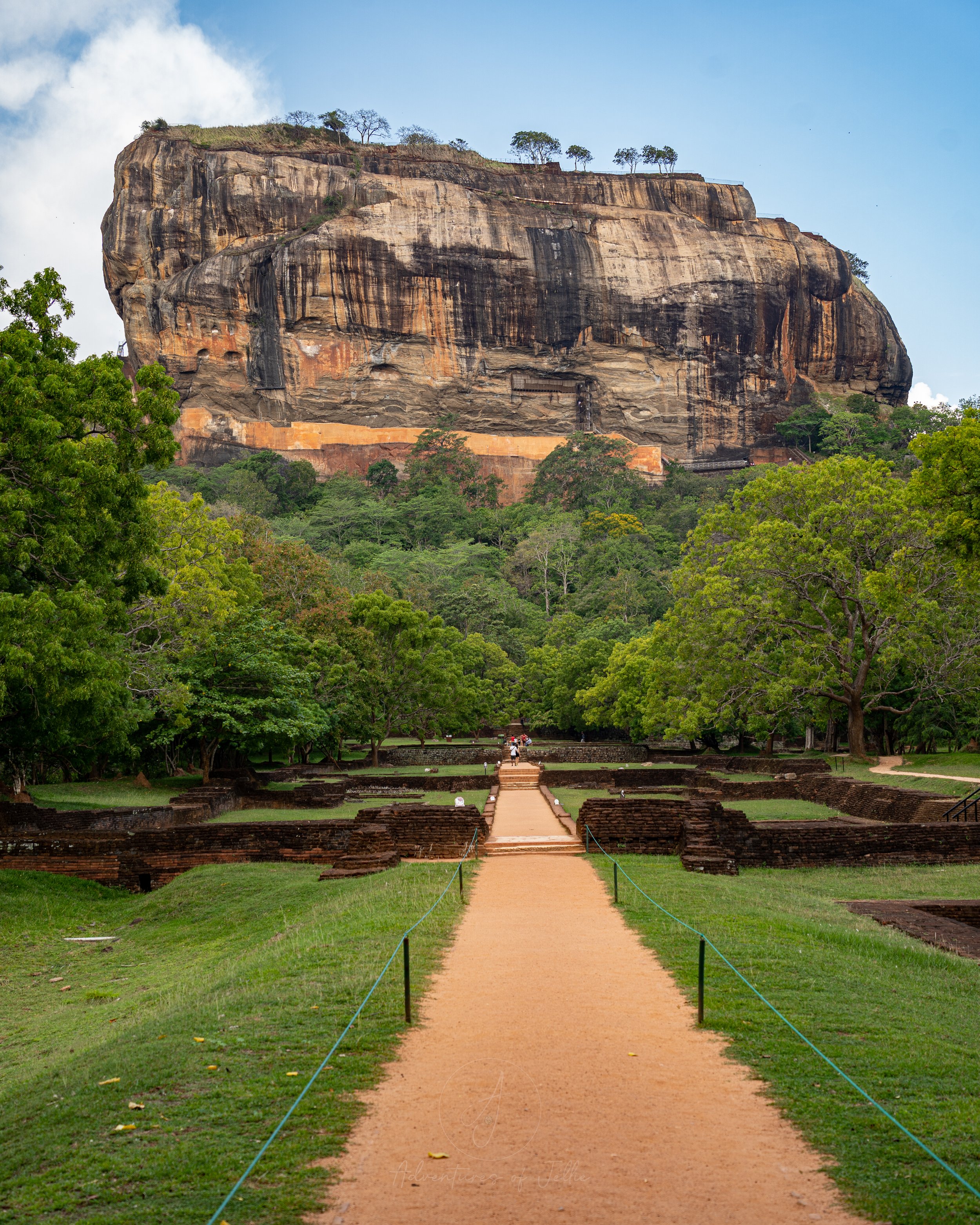


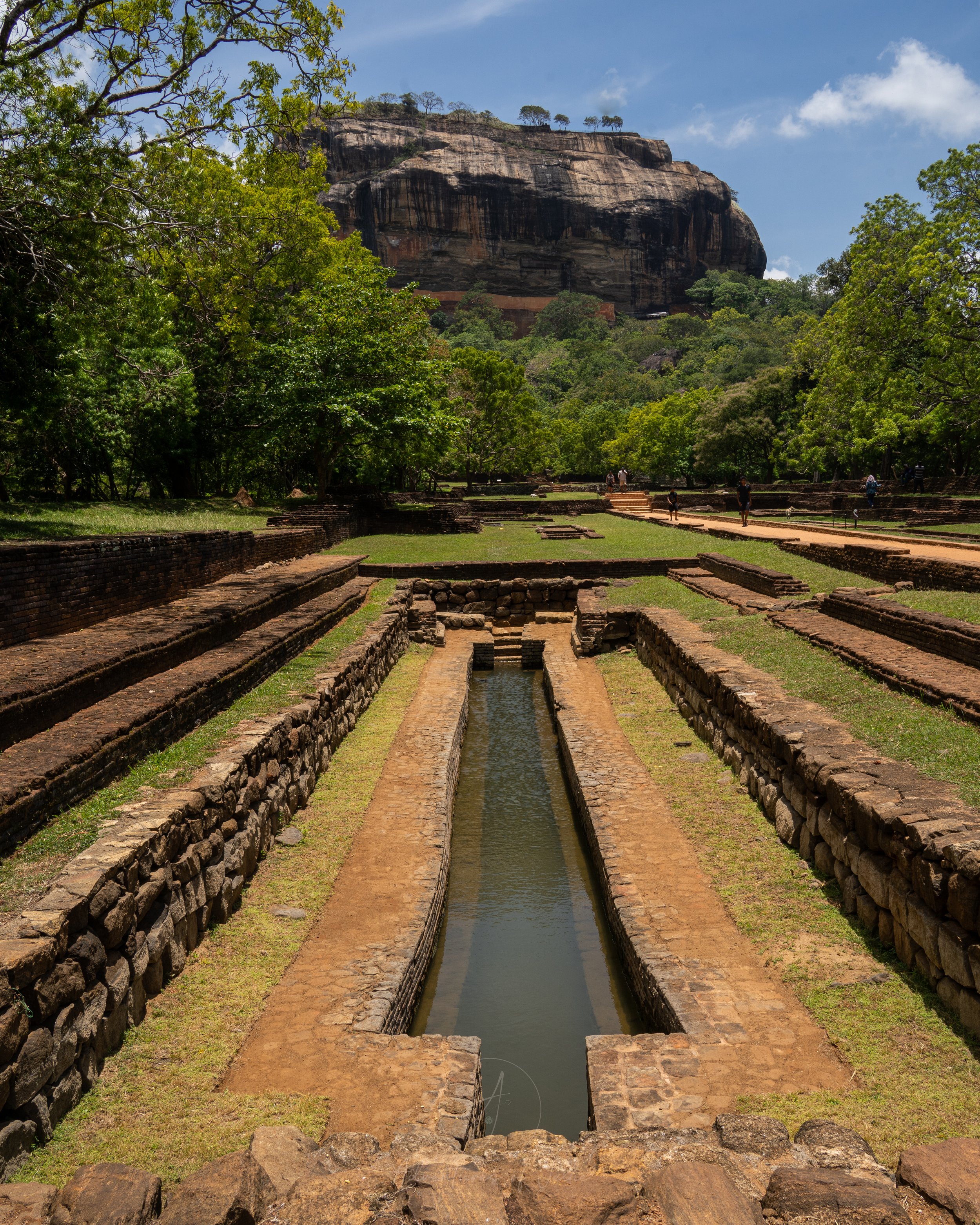

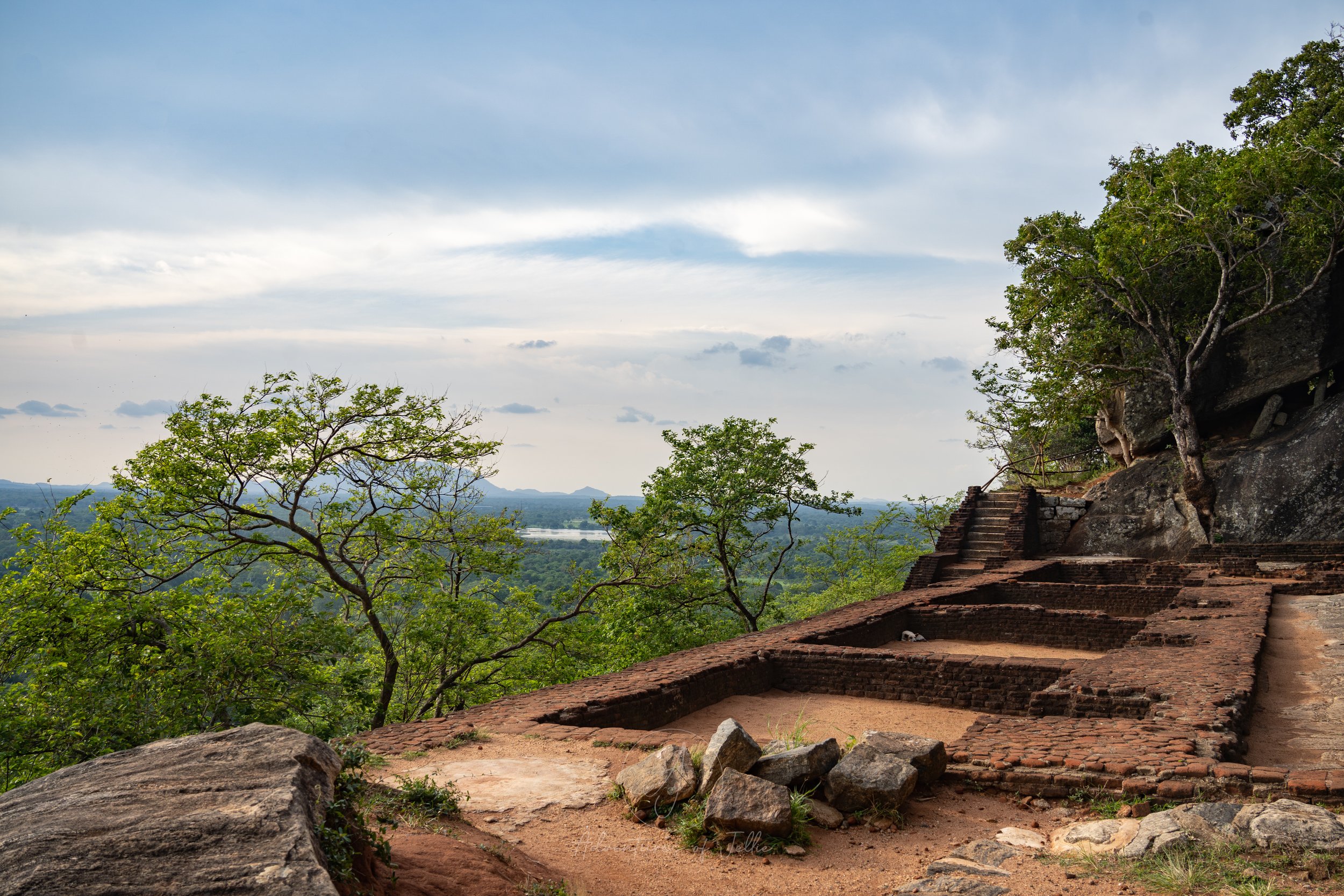


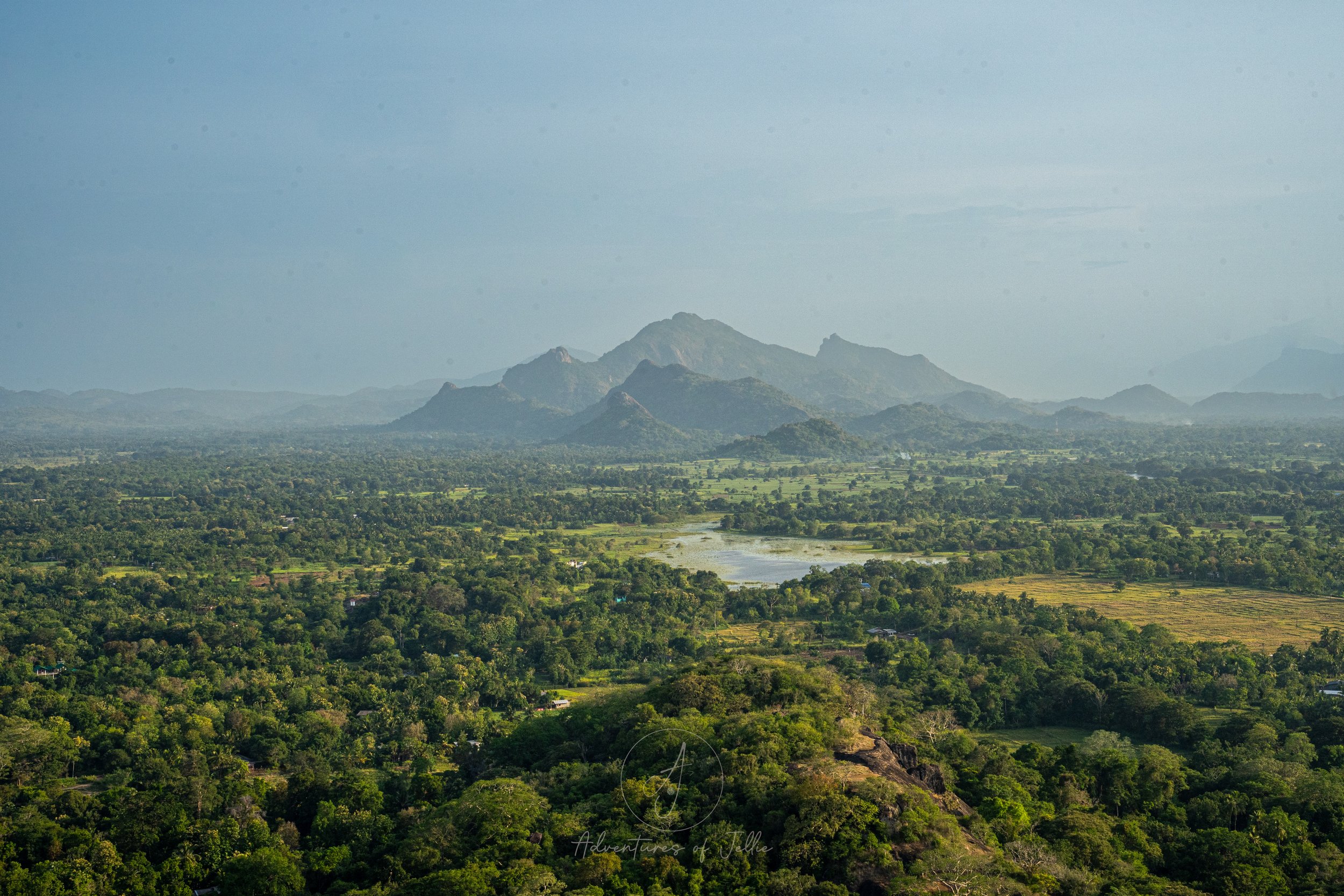


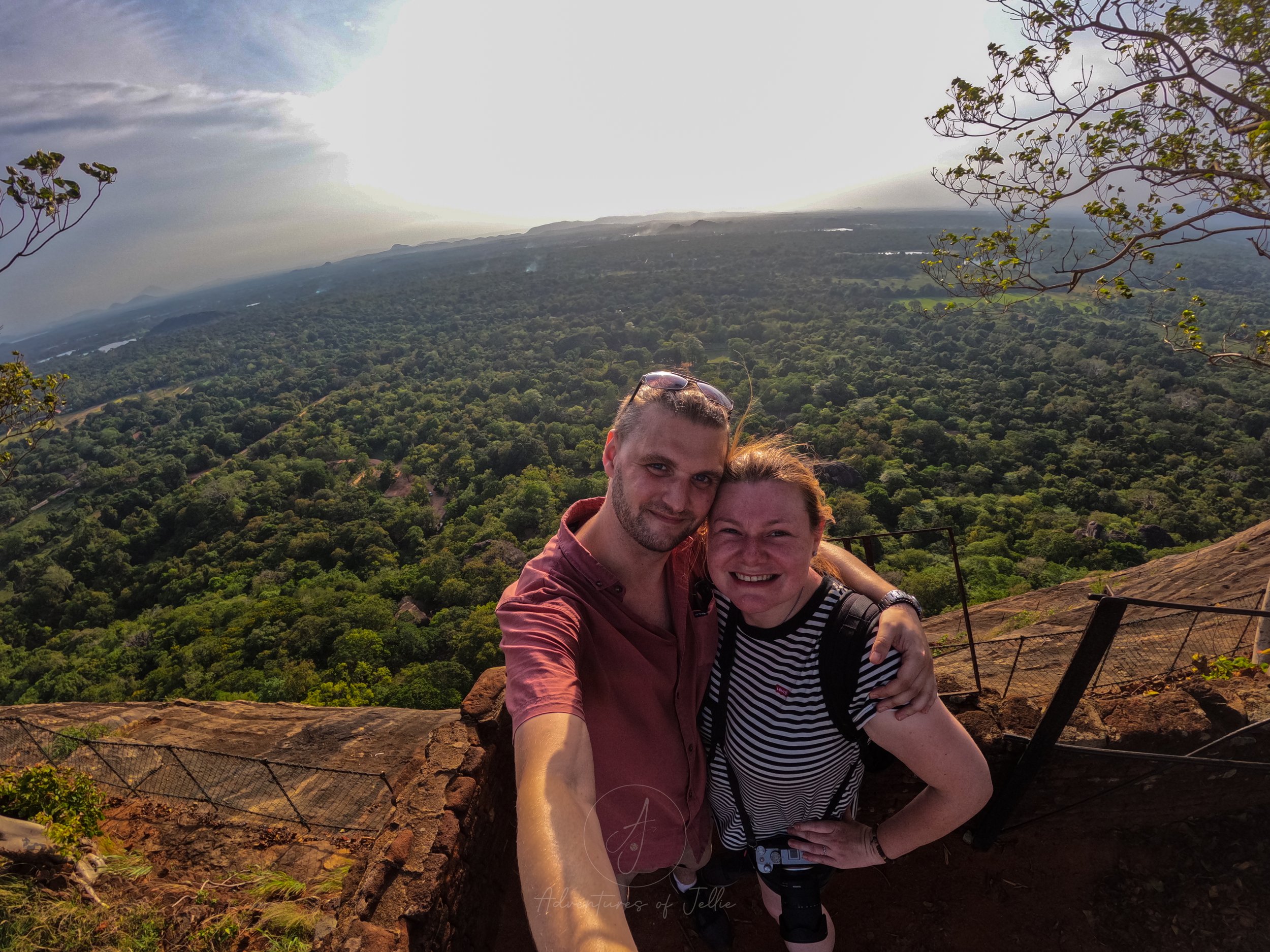









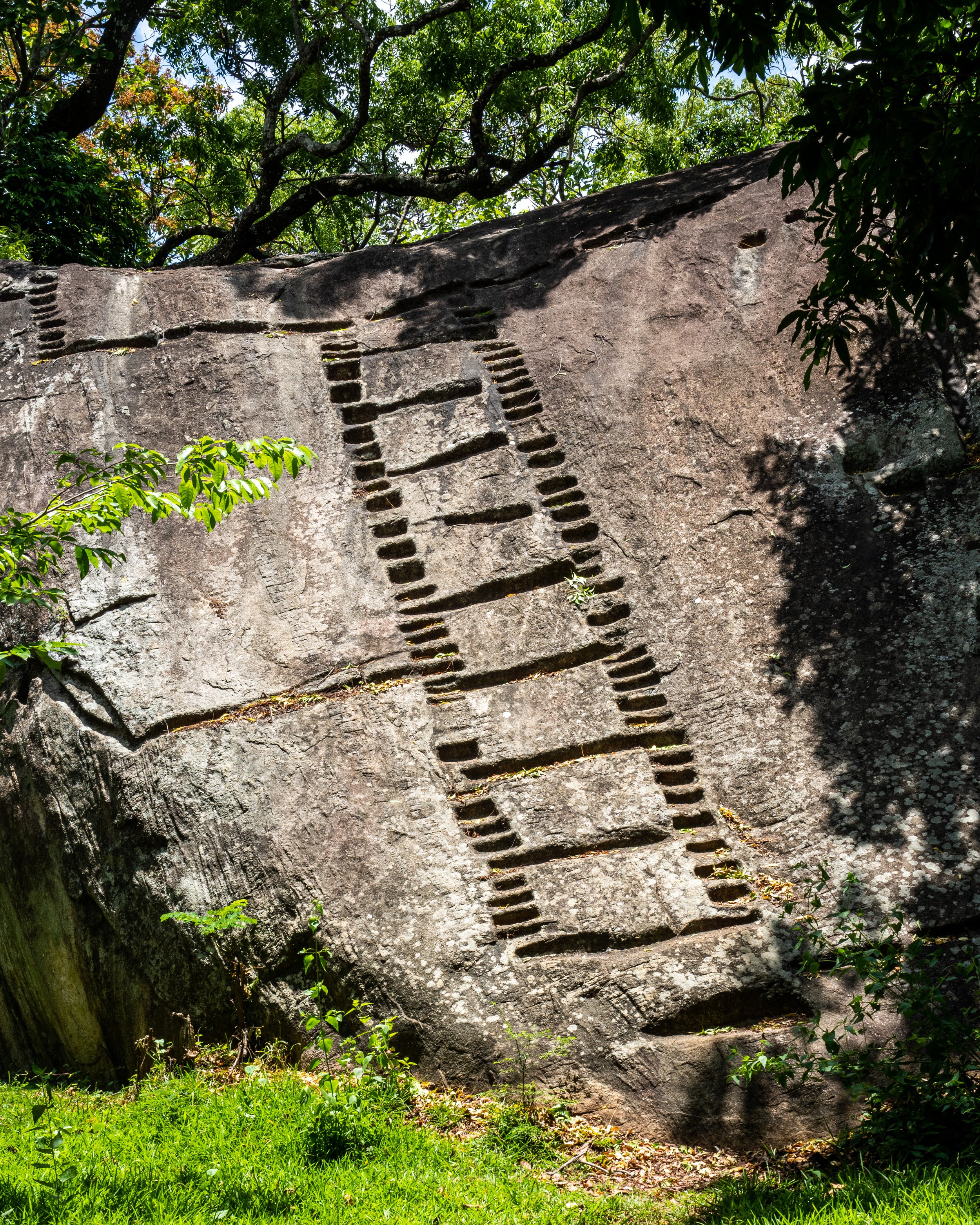













Nearby to Dambulla, Sigiriya, and Polonnaruwa as well as the National Parks of Kaudulla and Minneriya, Habarana is the gateway to some of the highlights of central Sri Lanka. Read our guide to Habarana, our accommodation and the food we ate!